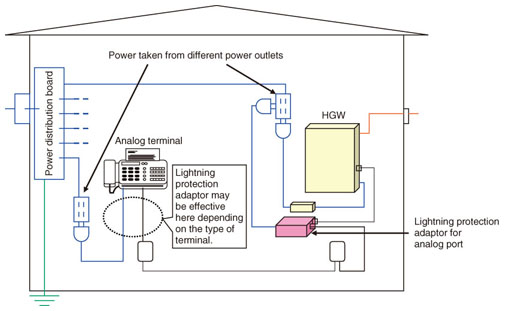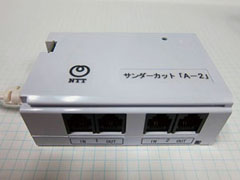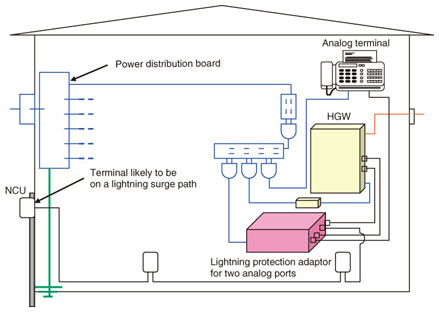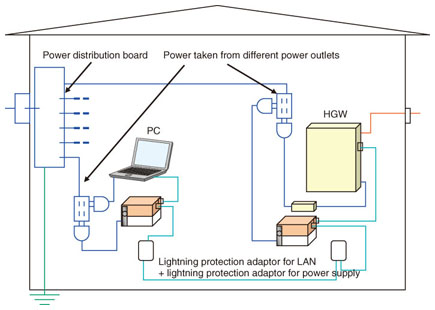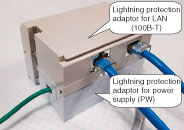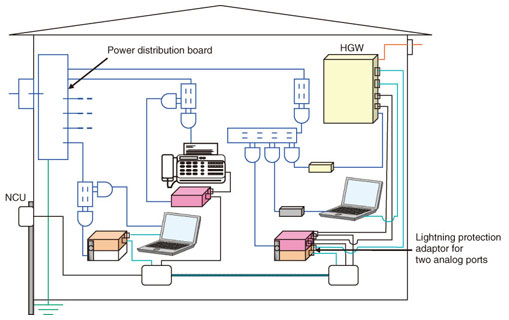 |
|||||
|
|
|||||
|
Practical Field Information about Telecommunication Technologies Vol. 10, No. 4, pp. 35–39, Apr. 2012. https://doi.org/10.53829/ntr201204pf1 Countermeasures to Lightning Damage in Home Gateways Supporting FTTH ServicesAbstractThis article introduces lightning damage countermeasures for home gateways supporting fiber-to-the-home (FTTH) services, which have been developed by NTT EAST. It is the tenth in a bimonthly series on the theme of practical field information about telecommunication technologies. This month's contribution is from the EMC Engineering Group, Technical Assistance and Support Center, Maintenance and Service Operations Department, Network Business Headquarters.
1. IntroductionThe number of lightning-related failures of communication terminals such as home gateways (HGWs) was expected to decrease as metallic-circuit services are replaced by optical fiber-to-the-home (FTTH) services. However, it has become clear that the number of lightning-related failures of HGWs is not so different from that of integrated services digital network (ISDN) terminal adaptors and digital service units or asynchronous digital subscriber line (ADSL) modems using metallic circuits. We analyzed HGW failures and the manner in which customers use communication equipment. We found that the cause of lightning damage to HGWs was essentially unrelated to the transmission medium but closely related to lightning-induced current surges entering through the power-supply lines of equipment connected to the HGW's analog ports, local area network (LAN) ports, and other ports. This article introduces specific countermeasures to lightning damage to HGWs for various HGW usage formats. 2. Countermeasures to HGW lightning damage2.1 One telephone unitFirst, we describe a countermeasure when an HGW supporting Internet protocol (IP) telephony has one mains-powered analog terminal connected to it. If the power supplies of both the HGW and analog terminal are connected to different power outlets, a lightning surge current entering through the home's power distribution board could generate a potential difference between the two power outlets, which could cause damage to both the HGW and analog terminal. A countermeasure to this problem is shown in Fig. 1. A lightning protection adaptor for analog port (Thundercut A-2 (Photo 1)) is installed between the power-supply line and analog port so that any lightning surge currents bypass the HGW via a surge protective device. It is recommended to install a lightning protection adaptor on both the HGW and analog-terminal sides. However, some business phones and fax machines incorporate lightning protection circuits and devices similar to lightning protection adaptors, so it may not be necessary to install an adaptor on the analog-terminal side.
Connecting both the HGW and analog terminal to the same power outlet can practically eliminate any potential difference between the two. Therefore, this configuration results in a low risk of lightning damage to the HGW and analog terminal. If both the HGW and analog terminal are installed in the same room, it is recommended that they be supplied power from the same power outlet if at all possible. 2.2 Multiple telephone unitsMany HGWs that support IP telephony have multiple analog ports and, in many cases, the HGW has more than one analog terminal connected to it irrespective of the number of IP-telephone subscriber lines. If there are many HGW and analog-terminal connections, there is a high probability that at least one analog terminal will receive power from a different power outlet from the HGW, which opens up the possibility of lightning-related damage. Moreover, among the equipment connected to the analog ports, a network control unit (NCU) for reading the gas meter, supporting a security system, etc. may be connected to an electrical earth that could act as a path for lightning backflow current [1]. In this case, the HGW should be connected to a power outlet separate from the NCU earth. A countermeasure for this usage format is shown in Fig. 2. Since existing HGWs often provide two ports, an effective method for protecting the HGW from lightning is to use a lightning protection adaptor with two analog ports. Therefore, the HGW can be protected by installing a lightning protection adaptor, but a surge current can still flow toward the telephone units in the same manner as when only one unit is used. For this reason, adding lightning protection adaptors separately for the telephone units can also protect them from lightning damage.
2.3 One personal computerThe countermeasure to lightning damage when the HGW has one personal computer (PC) connected to it is basically similar to that for one analog terminal. Here too, lightning damage is more likely to occur if the PC is connected to a different power outlet from the HGW. In this case, one countermeasure is to add a lightning protection adaptor for LAN in combination with a lightning protection adaptor for power supply, as shown in Fig. 3. An external view of this combined adaptor is shown in Photo 2 (lightning protection adaptor for LAN 100B-T and lightning protection adaptor for power supply PW). If the HGW's LAN port is damaged by lightning, there is a high probability of the PC connected to that port being affected. It is therefore recommended that countermeasures to lightning damage be applied to both the HGW and PC.
In the case of a wireless LAN, there is no route between the HGW and PC for lightning surge current to take. However, there is a risk of lightning-related damage if the wireless router's power supply is connected to a different power outlet from the HGW. 2.4 Multiple analog terminals and PCsHere, we present a comprehensive countermeasure to lightning damage when the HGW has multiple analog terminals and PCs (or hubs) connected to it. In the example shown in Fig. 4, the HGW is connected to one telephone unit that incorporates a fax function, one NCU for reading the gas meter, and two PCs using Ethernet cables. In this case, if even one piece of equipment connected to one of the HGW's ports is using a different power outlet from the HGW, then lightning damage countermeasures must be applied to all of the HGW's ports. Moreover, since a PC does not have a surge-bypass circuit, if a PC is connected to the same power outlet as the HGW, then it is necessary to protect the HGW by using a lightning protection adaptor for the other ports.
The housings for the Thundercut A-2 and 100B-T adaptors can be integrated into one unit by a sliding mechanism. The ground terminals for both housings can also be linked via its coupling bar. Moreover, if there is felt to be a need to protect equipment on the other side of an adaptor, then it is recommended that a separate lightning protection adaptor be installed for that equipment. 3. ConclusionThis article presented examples of countermeasures to lightning-related damage for a variety of customer usage formats using lightning protection adaptors developed by the Technical Assistance and Support Center. In the future, HGW interfaces are expected to become increasingly diverse. There are already ones with a coaxial port for broadband television, and the addition of USB (universal serial bus) ports is under study (USB-type ADSL modems already exist). At present, there is not a complete lineup of anti-lightning products for all interfaces, so appropriate schemes for connecting the HGW and user equipment to power outlets and the introduction of wireless LANs will continue to be effective countermeasures to lightning damage. Nevertheless, the Technical Assistance and Support Center is constantly surveying the surge resistance of commercially available user equipment and anti-lightning products and working to develop anti-lightning products for new HGW interfaces. To further reduce lightning-related failures in communication equipment, including HGWs, from here on, we plan to conduct on-site surveys and continue to develop anti-lightning products and lightning-protection measures while actively holding seminars on lightning countermeasures for on-site maintenance personnel in various regions of the country, updating websites about countermeasures to lightning damage, and so on. Reference
|
|||||









